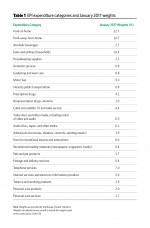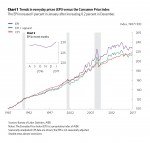Food, Energy, and Health Care Lead Everyday Prices Higher
AIER’s monthly Everyday Price Index rose 1 percent in January led by food, energy, and health-care prices. The EPI measures price changes that people see in everyday purchases such as groceries, gasoline, utilities, and personal-care products. Over the past 12 months the EPI has increased 2.5 percent.
The EPI including apparel, a broader measure, rose 0.9 percent. Over the past 12 months, the broader index has increased 2.4 percent. Both measures exclude prices of infrequently purchased, big-ticket items (such as cars, appliances, and furniture) and prices that are contractually fixed for prolonged periods (like housing).
The more widely known price gauge, the Consumer Price Index reported by the U.S. Bureau of Labor Statistics, rose 0.6 percent on a seasonally unadjusted basis in January and increased 2.5 percent over the past 12 months. The EPI is not seasonally adjusted, so we compare it with the unadjusted CPI.
Prices at groceries and restaurants pushed everyday prices higher in January, both increasing 0.4 percent. However, over the past year prices at the grocery store and prices at restaurants have diverged. Over past 12 months food prices at groceries have fallen 1.9 percent, while food prices at restaurants have risen 2.4 percent. Strong consumer demand has spurred price increases at restaurants.
Gasoline prices have also hiked everyday prices. Gas increased across all grades in January. Regular rose 5.5 percent, midgrade increased 4.9 percent, and premium was up 4.3 percent. Over the past year, gasoline prices have climbed 20.3 percent.
Rising health-care prices are a major concern for households. Prescription drug prices led everyday prices higher in January, rising 0.8 percent. Over the past year prescription drug prices have increased 6.1 percent, much faster than their 10-year average increase of 3.5 percent. Prices for medical-care services are up 3.6 percent over the past year. They have been driven higher by price increases for physician and hospital services. Prices for medical-care commodities and equipment have provided some relief, falling 0.1 percent during the past year. Looking ahead, if the Affordable Care Act is repealed, many households will be facing more uncertainty around health-care prices.






